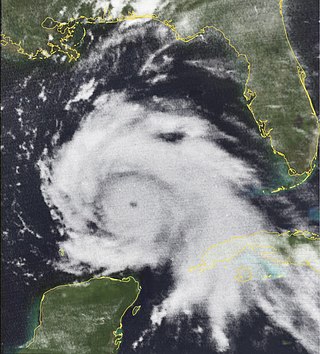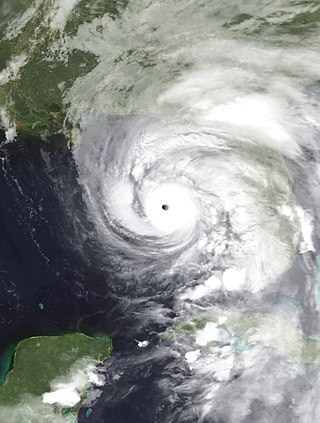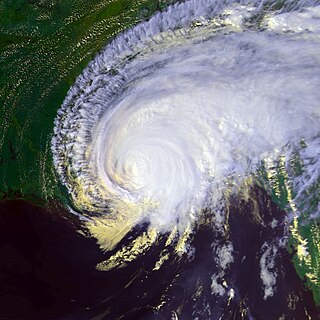
Hurricane Camille was a powerful, deadly and destructive Category 5 major hurricane which became the second most intense tropical cyclone on record to strike the United States and is one of just four Category 5 hurricanes to make landfall in the U.S.

Hurricane Charley was the first of four separate hurricanes to impact or strike Florida during 2004, along with Frances, Ivan and Jeanne, as well as one of the strongest hurricanes ever to strike the United States. It was the third named storm, the second hurricane, and the second major hurricane of the 2004 Atlantic hurricane season. Charley lasted from August 9 to 15, and at its peak intensity it attained 150 mph (240 km/h) winds, making it a strong Category 4 hurricane on the Saffir–Simpson scale. It made landfall in Southwest Florida at maximum strength, making it the strongest hurricane to hit the United States since Hurricane Andrew struck Florida in 1992 and tied with Hurricane Ian as the strongest hurricane to hit southwest Florida in recorded history.

Hurricane Iniki was the most powerful hurricane to strike Hawaiʻi in recorded history, and the only hurricane to directly affect the state during the 1992 Pacific hurricane season. Forming on September 5, 1992, during the strong 1990–1995 El Niño, Iniki was one of eleven Central Pacific tropical cyclones during that season. It attained tropical storm status on September 8 and further intensified into a hurricane the next day. After turning north, Iniki struck the island of Kauaʻi on September 11 at peak intensity; it had winds of 145 mph and reached Category 4 status on the Saffir–Simpson hurricane scale. It had recorded wind gusts of 225 mph (362 km/h) as evidenced by an anemometer that was found blown into the forest during clean up. It was the first hurricane to hit the state since Hurricane Iwa in the 1982 season, and is the only known major hurricane to hit the state. Iniki dissipated on September 13 about halfway between Hawaii and Alaska.

Hurricane Beulah was the second tropical storm, second hurricane, and only major hurricane during the 1967 Atlantic hurricane season. It tracked through the Caribbean, struck the Yucatán Peninsula of Mexico as a major hurricane, and moved west-northwestward into the Gulf of Mexico, briefly gaining Category 5 intensity. It was the strongest hurricane during the 1967 Atlantic hurricane season. The hurricane made landfall just north of the mouth of the Rio Grande as a Category 3 hurricane. It spawned 115 tornadoes across Texas, which established a new record for the highest amount of tornadoes produced by a tropical cyclone. Due to its slow movement over Texas, Beulah led to significant flooding. Throughout its path, at least 59 people were killed and total damage reached $234.6 million, of which $200 million occurred in the United States, $26.9 million occurred in Mexico, and $7.65 million occurred in the eastern Caribbean.

Hurricane Elena was a strong and destructive tropical cyclone that affected eastern and central portions of the United States Gulf Coast in late August and early September 1985. Threatening popular tourist destinations during Labor Day weekend, Elena repeatedly deviated from its forecast path, triggering evacuations of unprecedented extent. The hurricane wrought havoc to property and the environment between southwestern Florida and eastern Louisiana, though lesser effects were felt well beyond those areas. Elena developed on August 28 near Cuba, and after traveling lengthwise across the island with little impact, it entered the Gulf of Mexico and continued to strengthen. Initially projected to strike the central Gulf Coast, the hurricane unexpectedly veered toward the east on August 30, then stalled just 50 mi (80 km) west of Cedar Key, Florida. Despite predictions that Elena would continue eastward across Florida, the cyclone remained nearly stationary for about 48 hours, causing damage all along the eastern gulf with high winds and waves, before slowly moving northwest and ultimately making landfall near Biloxi, Mississippi, on September 2 as a Category 3 major hurricane. The storm quickly weakened upon moving ashore and dissipated on September 4.

Hurricane Fifi, later known as Hurricane Orlene, was a catastrophic tropical cyclone that killed over 8,000 people in Honduras in September 1974, ranking it as the third deadliest Atlantic hurricane on record, only behind Hurricane Mitch in 1998, and the 1780 hurricane. Fifi is also the first billion-dollar hurricane not to make landfall in the U.S. Originating from a strong tropical wave on September 14, the system steadily tracked west-northwestward through the eastern Caribbean. On September 16, the depression intensified into Tropical Storm Fifi just off the coast of Jamaica. The storm quickly intensified into a hurricane the following afternoon and attained its peak intensity on September 18 as a strong Category 2 hurricane. Maintaining hurricane intensity, Fifi brushed the northern coast of Honduras before making landfall in Belize the following day. The storm quickly weakened after landfall, becoming a depression late on September 20. Continuing westward, the former hurricane began to interact with another system in the eastern Pacific.

Emergency evacuation is an immediate egress or escape of people away from an area that contains an imminent threat, an ongoing threat or a hazard to lives or property.

Hurricane Dennis was an early-forming major hurricane in the Caribbean and Gulf of Mexico during the record-breaking 2005 Atlantic hurricane season. Dennis was the fourth named storm, second hurricane, and first major hurricane of the season. Forming in July, the hurricane became the strongest Atlantic hurricane ever to form before August at the time, a title it held for only six days before being surpassed by Hurricane Emily.

Hurricane Emily was a powerful early season Cape Verde hurricane that caused significant damage across the Caribbean to Mexico. It was also the earliest-forming Category 5 Atlantic hurricane on record in a season and the most intense to form before August. At the time, Emily was the earliest-forming fifth named storm in the Atlantic on record; this record has since been surpassed by 2020's Tropical Storm Edouard, and again the following year by 2021's Hurricane Elsa. After forming on July 10, 2005, the storm moved through the central Atlantic Ocean before passing through the Windward Islands on July 14. Tracking generally towards the west-northwest, the storm gradually intensified as it traversed the Caribbean, peaking as a Category 5 hurricane on July 16, marking the earliest date for a storm to do so during the course of a given year. The system subsequently made landfall in the Yucatán Peninsula as a Category 4. Quickly crossing the peninsula, Emily emerged into the Gulf of Mexico and reorganized. On July 20, the storm struck Tamaulipas as a major hurricane and rapidly dissipated within 24 hours. The storm caused significant damage along its path, with up to $1.01 billion in damages recorded, primarily in Mexico. 5 people died in each of Jamaica, Haiti, and Mexico; 2 people died elsewhere, for a total of 17 fatalities.

Hurricane Wilma was the most intense tropical cyclone ever recorded in the Atlantic basin, and the second-most intense tropical cyclone recorded in the Western Hemisphere, after Hurricane Patricia in 2015. Part of the record-breaking 2005 Atlantic hurricane season, which included three of the ten most intense Atlantic hurricanes in terms of barometric pressure, Wilma was the twenty-second storm, thirteenth hurricane, sixth major hurricane, fourth Category 5 hurricane, and the second-most destructive hurricane of the 2005 season. Its origins came from a tropical depression that formed in the Caribbean Sea near Jamaica on October 15, headed westward, and intensified into a tropical storm two days later, which abruptly turned southward and was named Wilma. Wilma continued to strengthen, and eventually became a hurricane on October 18. Shortly thereafter, explosive intensification occurred, and in only 24 hours, Wilma became a Category 5 hurricane with wind speeds of 185 mph (298 km/h).

Hurricane Irene produced somewhat heavy damage across southern Florida in October 1999. The ninth named storm and the sixth hurricane of the season, Irene developed in the western Caribbean Sea on October 13 from a tropical wave. It moved northward, hitting western Cuba before attaining hurricane status. Irene struck Florida on October 15 as a Category 1 on the Saffir–Simpson Hurricane Scale, first at Key West and later near Cape Sable. The storm moved across the state and tracked northward over the Gulf Stream. It approached the Carolinas but remained offshore. Irene turned eastward and significantly intensified into a strong Category 2 hurricane on October 18. By the following day, the system became extratropical due to cooler waters to the southeast of Newfoundland and was quickly absorbed by another extratropical low.

This article covers the details of the Preparations for Hurricane Katrina, a major category 5 hurricane that devastated parts of New Orleans, Florida, Louisiana, Mississippi, and Alabama, as well as the Hurricane Pam simulation and NWS forecasts that led to the U.S. government's decision to establish a Bipartisan Congressional Committee to investigate the country's preparedness for and response to Hurricane Katrina.

The effects of Hurricane Dennis in Florida included 14 deaths and $1.5 billion in damage. The tropical wave that became Hurricane Dennis formed on June 29, 2005, and proceeded westward across the Atlantic Ocean. It became a tropical depression on July 4, a tropical storm on July 5, and a hurricane on July 7. Dennis rapidly intensified to attain Category 4 status on the Saffir-Simpson Hurricane Scale, and made landfall in Cuba where it weakened to Category 1 status, before re-emerging in the Gulf of Mexico and re–intensifying. The storm made landfall as a Category 3 hurricane on Santa Rosa Island on July 10.

The effects of Hurricane Georges in Louisiana included $30.1 million in damage and three deaths. Forming from a tropical wave over the Atlantic Ocean, Georges attained a peak intensity of 155 mph (249 km/h) on September 20, 1998. Over the following several days, the storm tracked through the Greater Antilles and later entered the Gulf of Mexico on September 28, the Category 2 storm made landfall in Mississippi before dissipating on October 1. Before landfall, about 500,000 residents in Louisiana evacuated from low-lying areas. The mayor of New Orleans declared a state of emergency to allow federal assistance into the state. After nearly 1.5 million people were urged to evacuate coastal areas, officials described the evacuation as "probably the largest [...] we have ever achieved".

Hurricane evacuation is the immediate and rapid movement of people away from the threat or actual occurrence of a hurricane. County judges, emergency managers and other officials may recommend a voluntary evacuation or order a mandatory evacuation.

Hurricane Ida was the strongest landfalling tropical cyclone during the 2009 Atlantic hurricane season, crossing the coastline of Nicaragua with winds of 80 mph (130 km/h). The remnants of the storm became a powerful nor'easter that caused widespread damage along coastal areas of the Mid-Atlantic States. Ida formed on November 4 in the southwestern Caribbean, and within 24 hours struck the Nicaragua coast with winds of 80 mph (130 km/h). It weakened significantly over land, although it restrengthened in the Yucatán Channel to peak winds of 105 mph (170 km/h). Hurricane Ida weakened and became an extratropical cyclone in the northern Gulf of Mexico, before spreading across the southeastern United States. The remnants of Ida contributed to the formation of a nor'easter that significantly affected the eastern coast of the United States.

In early July 2005, Hurricane Dennis brushed Jamaica, bringing torrential rain and damaging floods to the island nation. Forming from a tropical depression on July 4, Dennis began impacting Jamaica three days later. Approximately 6,000 people evacuated from coastal and flood-prone areas prior to the storm's arrival while relief agencies allocated resources for recovery operations. Passing northeast of the island, impact from Dennis stemmed primarily from rainfall—accumulations peaked at 24.54 in (623 mm) and reached 1-in-50 year event levels. Widespread flooding and landslides damaged homes and isolated communities. Saint Thomas and Portland Parishes were hardest-hit; hundreds required evacuation as multiple rivers burst their banks.

Hurricane Matthew was an extremely powerful Atlantic hurricane which caused catastrophic damage and a humanitarian crisis in Haiti, as well as widespread devastation in the southeastern United States. The deadliest Atlantic hurricane since Hurricane Stan in 2005, and the first Category 5 Atlantic hurricane since Felix in 2007, Matthew was the thirteenth named storm, fifth hurricane and second major hurricane of the 2016 Atlantic hurricane season. It caused extensive damage to landmasses in the Greater Antilles, and severe damage in several islands of the Bahamas which were still recovering from Joaquin, which had pounded the archipelago nearly a year earlier. Matthew also approached the southeastern United States, but stayed just offshore, paralleling the Florida coastline.

The COVID-19 pandemic coincided with record-breaking wildfires in the western United States and a record number of hurricane landfalls in the southeastern United States. Emergency evacuation may be required for people living in areas threatened by natural disasters. Historic procedures maximizing capacity of public transport and emergency shelters may be inconsistent with quarantine and physical distancing measures related to the COVID-19 pandemic. It is not advisable to set up congregate shelters in an environment heavily impacted by a pandemic. Non-congregate shelters typically provide more effective physical distancing. Examples include buildings with single room occupancy, hotels or dormitories with private sleeping spaces but possibly shared bathroom or cooking facilities. Thousands of evacuees from Hurricane Laura were still in emergency lodgings as Hurricane Delta approached the Louisiana coast. Six-thousand from southwest Louisiana were in twelve New Orleans area hotels. Three-thousand-five-hundred remained in shelters as Hurricane Zeta approached Louisiana. A volcanic eruption on the island of Saint Vincent in April 2021 caused evacuation of sixteen-thousand people. Four-thousand evacuees were placed in eighty-nine government shelters after being tested for COVID-19, with those testing positive taken to isolation centers. Six-thousand evacuees found shelter in private homes.

Hurricane Sally was a destructive and slow-moving Atlantic hurricane that was the first hurricane to make landfall in the U.S. state of Alabama since Ivan in 2004, coincidentally on the same date in the same place. The eighteenth named storm and seventh hurricane of the extremely active 2020 Atlantic hurricane season, Sally developed from an area of disturbed weather which was first monitored over the Bahamas on September 10. The system grew a broad area of low-pressure on September 11, and was designated as a tropical depression late that day. Early the next day, the depression made landfall at Key Biscayne and subsequently strengthened into Tropical Storm Sally that afternoon. Moderate northwesterly shear prevented significant intensification for the first two days, but convection continued to grow towards the center and Sally slowly intensified. On September 14, a center reformation into the center of the convection occurred, and data from a hurricane hunter reconnaissance aircraft showed that Sally had rapidly intensified into a strong Category 1 hurricane. However, an increase in wind shear and upwelling of colder waters halted the intensification and Sally weakened slightly on September 15 before turning slowly northeastward. Despite this increase in wind shear, it unexpectedly re-intensified, reaching Category 2 status early on September 16 before making landfall at peak intensity at 09:45 UTC on September 16, near Gulf Shores, Alabama, with maximum sustained winds of 110 mph (180 km/h) and a minimum central pressure of 965 millibars (28.5 inHg). The storm rapidly weakened after landfall before transitioning into an extratropical low at 12:00 UTC the next day. Sally's remnants lasted for another day as they moved off the coast of the Southeastern United States before being absorbed into another extratropical storm on September 18.



















